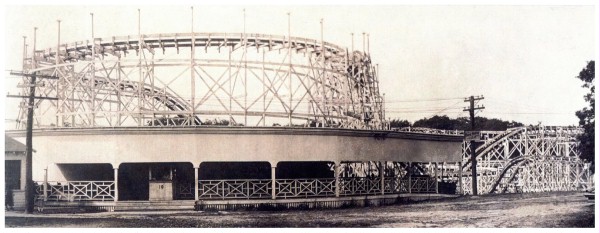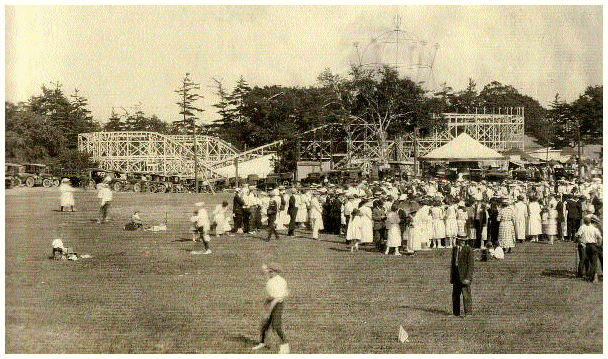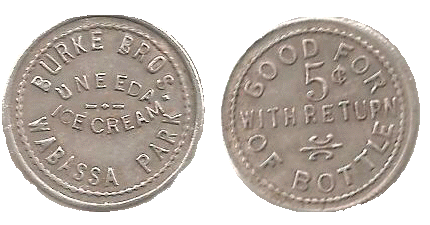
ONTARIO

Burlington
NO PART OF THE FOLLOWING
MAY BE REPRODUCED WITHOUT
PERMISSION FROM THE AUTHOR ©
This park had its roots near an area called "Oaklands", which came to have its own pleasure grounds. It started as a crown grant of 800 hectares to Lieutenant Alexander McDonnell in 1796. 360 hectares of this were designated as Lots 6, 7, and 8, and were sold to William Applegarth in 1809. He farmed part and built homes on the rest.
Upon Applegarth's death in 1832, his daughter Sarah inherited Lot 6 and half of Lot 7. Lot 8 went to his son William along with the remainder of Lot 7. On the latter he built a large, 26-room house, and opened a 16-hectare park in 1854, which at some point went under the name of "Oaklands Pleasure Grounds". It included a garden and wooded area. A pier, built around 1840 to accommodate travel to and from locations on Lake Ontario, was used to access the pleasure grounds. One of the ferries was "Victoria". Road travel was available as well, being only 10 km from Hamilton. Dinners and drinks were served in the main part of the house, where dancing was also a feature. Rooms on the 2nd floor were possibly where the proprietor and/or guests would stay.
Also in 1854, William must have entered into a lease agreement because in 1858 the remaining 16-year lease on the park was offered for sale, not by him, but by T. N. Best and J. B. Harrison. This included the house, the gardens and the wooded area. Perhaps William was not the one to develop Lot 7, but Best and Harrison were.
The property was eventually bought by Charles Davidson in 1872. (The 1877 map farther on shows his name as owner of Lots 7 and 8.) He built a gate house at the intersection of Plains and Howard roads as an entrance to the estate. It is unclear if after his purchase he ran it as a park, nor whether it was run as such between the advertised sale year of 1858 and the purchase year of 1872. Regardless, by 1878, it was no longer operated as a pleasure ground.
In 1881 the land was acquired by Valancey Fuller whose father was Thomas Brock Fuller, the first Bishop of Niagara. The area was then known as the "Oaklands Jersey Farm", and it was resold in 1889 to Thomas Townsend. He was a developer and engineer, having designed the Welland Canal's locks, gates and bridges, and rebuilding Desjardins Canal bridge after an accident. He also designed a custom rail car for future King Edward VII; it was for his 1860 cross-Canada trip when Edward was still Prince of Wales.
Thomas or his daughter would lease out the former pleasure grounds on Lot 7 for Church picnics. The land would remain with his family until 1952.
Getting back to the Applegarths, Sarah died in 1864 leaving her part of the original property to her husband Alexander Brown. After he died in 1880, their son Alexander inherited it. A relative, P.W. Brown, would eventually sell Lot 6 to the City of Hamilton for $52,673 in 1912. (Some sources give a sale date of 1913 or 1915, but a newspaper article shows that the purchase decision was made by the Parks Board of Management in 1912. The other years may represent a delay in the actual sale closing date.)
After the sale, the city named the new place "Wabaso", a native word meaning "northwind" ("white rabbit" says another source). It later came to be spelled "Wabasso". By 1915 if not earlier, Hamilton's Parks Board made available a new 20-hectare park to the public for recreational purposes. It was situated beside the former Oaklands property. The Board also petitioned for ferry service to the pier that had become known as "Brown's Wharf"; several companies expressed interest.
|
The closest sections to Lake Ontario of Lots 8 through 5 are numbered on this clarified map. To the right of Davidson's Oaklands area is Lot 6. This is where Wabasso Park will come to be. Brown's Wharf is shown attached to this Lot. |

The black square below the rectangle of dots in Lot 6 is the location of Alexander Brown's house. This is on, or next to, where the Pavilion and Roller Coaster would be built many decades later. |
For the 1917 season (1918 from another source), a community building known as the "Pavilion" was erected by the city. Because no date for the demolition of the former Brown house has surfaced, it is not clear if the Pavilion was built in its place, or if both existed for a time.
At some point, a portion of the land was leased to Canada Steamship Lines (CSL) which was just getting into the amusement park business. An official date for the park to open was June of 1918, but it's not known if this was the start of CSL's involvement or if they were there earlier -- perhaps as one of the interested ferry companies. CSL also bought or leased Grimsby Park around this time. As they wished to run ferries to these areas to garner more business, some attractions for ferry riders to visit would be necessary.
Consequently, CSL invested $150,000 to upgrade the wharf and to make improvements to the park. Additions of athletic fields, a dance hall, picnic grove, and a restaurant were made. A concrete bathhouse was erected in 1922 to provide changing facilities for swimmers. The existing entrance gate and former Brown residence remained, and would stay as part of the grounds for over 30 years.
Amusement rides included a Figure 8 roller coaster. As the 1910s are a bit late for this model, it might have been purchased used. If this was the case, it may have come from the financially-suffering Frontier Amusement Park located across the short lakehead of Lake Ontario in Niagara Falls. The coaster designer is unknown, but common names of the era were Harton, Ingersol, and Miller. An opening date has not surfaced, but the earliest year would not have been before 1912, and the latest not likely beyond 1918. The most probable year for this ride's opening is 1915. Research continues...
|
Figure 8
Early 1920s Ride Entrance Stairs near the left Lead to this Attraction's Ticket Booth  |
|
Blocked from view by the station, the unseen lift
hill on the far side of the layout rises up to the
first drop. Trains descend to ground level while
diagonally crossing toward the station, where upon
the track rises to meet the first turnaround. Circling
to the left on the foreground track, riders approach
the second drop seen above the entrance in the background.
Next, the track dips to ground level and then rises straight to the second turnaround in the far right background. (The crest of this hill is just visible beyond the apparent junction of the structure and station roofline.) Trains now curve toward the viewer to encounter the drop seen to the right of the sign on the right-hand power pole. This leads to a near-ground-level crossover while heading to the far left and the third turaround. The track curves up, and now moving to the right, is hidden behind the station. Next, riders dip below ground level as seen beyond the base of the power pole. Topping that short hill, the train eventually circles counter-clockwise back toward the station where it enters from the left to stop at the loading platform. |
Although the ride was at least partially fenced in, there was a bystander fatality associated with this coaster. On July 25th of 1924, a five-year old boy gained access through the fence and was struck by a train. He died on site of his injuries.
Also in the park was an Ingersol Swing Around, a version of the Traver Circle Swing. (See pictures and a full description of the latter in the Scarboro Beach article.) There is little information regarding other amusement rides at this time, although one source does mention that a ferris wheel was in the park at some point. In addition, there appears to be a carousel in the photo below. Another source states there were a "variety of thrill rides", but it's unclear if this referred only to the four rides discussed or if there were also others.
|
Midway 1922  |
|
This shot of the midway features the
side of the Figure 8 opposite
the entrance. Clearly seen are the
lift hill at Center and the second
turnaround at Center Left.
Note the close parking of vehicles around the structure. The tower above the trees at Center Top is for the Ingersol Swing Around. The conical canopy at Center Right may house a carousel. |
In June of 1923 a memorial rock was placed with a plaque commemorating the nearby 1669 landing of explorer Rene-Robert Cavelier, Sieur de La Salle. It seems that the park's "Wabasso" name may have been changed to "La Salle Park" at this time, but other sources give the name change as not being until 1926 or 1927. The title was also used on a city-erected building as the "La Salle Park Pavilion". Despite this change, the "Wabasso" name seems to have survived to some extent after this. The pavilion continued into modern times, was closed in 1991, then renovated in 1994. In 1995, a fire damaged the second floor, but it was rebuilt to its original design two years later and is open today.
One of the food concessionaires was the Burke Brothers, who first had an operation in the park in 1919. They had a large company in Hamilton and made dairy products under a Uneeda Ice Cream license. They also were distributers of soda fountain equipment, as well as bottlers of their own soft drinks.
During their first season at the park, the Burkes were accused of over charging for their products. This was contrary to their agreement with the city which stated that they had to charge city rates. The Parks Board was slated to investigate and presumably did enforce the requirement.
|
Burke Brothers Token Date Unknown (Likely early 1920s)  |
| Note the spelling of "Wabasso". |
|
Eventually, the park began a slow decline; this seems to have had its beginnings in the mid 1920s. One factor might have been that swimming was becoming undesirable due to muddy water and contamination from sewage and oil. In addition, it's possible that competition from other parks might have been a factor. Given that more of the public was buying automobiles than ever before, meant parks farther from home could be reached more easily. Then there was the general loss of business during the depression that could have caused La Salle to decline further in the 1930s.
There is little reference as to the middle years of this park, but researcher Jim Abbate of Chicago contributes that advertised for 1936 were a penny arcade and four rides. Were these the Figure 8, Swing Around, carousel, and ferris wheel?
Also listed is a pool; this is suggestive because installing a pool may have been the park's way of abating the public's resistance to swimming that had risen due to the aforementioned water quality issues in the lake.
Given the decline, the amusements may have closed later in that decade or in the early 1940s. Although it is non-definitive evidence for those closure dates, it is significant that a 1946 amusement park directory lists neither La Salle nor Wabasso Park in either its `Amusements' or `Concessionairs' sections. (This directory came out in late 1945.)
However, these points are contradicted by a sales advertisement from March of 1947. It lists a number of amusement rides and accessories at La Salle Park, and that a new owner wanted to sell them so as to avoid having to store them. This implies that the park was sold in 1946 or 47, or perhaps earlier. Had this new owner or a previous owner tried to run the amusements for a few seasons, or did the latest owner simply buy them to sell at a profit? Regardless, the ad implies that the park was open in 1946, so one would think it would have been in that directory. However, not every Canadian amusement park was listed because not every park's office responded to the request of the directory's publishers.
As for the advertisement itself, based on
what is printed, here are some comments:
- A three-row carousel with a Wurlitzer military band organ was listed. If this is the same ride as was mentioned initially in this article, it had a life in the park of over 25 years. It was rebuilt in 1946 and a new khaki top installed.
- A "Seaplane" is mentioned. This sounds to be the Swing Around ride and that it had airplane-style cars. (These style of rides had a number of different-themed cars marketed to owners over the years.)
- A Mangels Whip is listed. This was a popular ride in many Canadian amusement parks in the 1920s. Might this have been there at a time to be included in the "variety of thrill rides" quote from farther back? This ride had been rebuilt in 1946 and had the engine replaced, thus indicating long usage.
- A new attraction for 1946 was the Boat Racer, a kiddie ride. The ad says it had been used for only one week. Was it bought near the end of the 1946 season? Or was it there at the start and the season cut short due to some problem, forcing the park to close early that year?
- Another is the Atomic Bomb. Details say it needs no power, and is built of steel with a canvas top. Given the "no power" phrase, it may have been a swing or slide, or was a human- or animal-driven ride. This may have been an existing attraction that was renamed after atomic weapons were used near the end of World War II.
- An eight-lane, outdoor bowling alley that was new in 1945.
- One "Snow-Ko-La" machine and building.
- In addition were two Eli power units, one that had been rebuilt in 1946, 36 picnic tables (built in 1946), and two PA systems -- one with an automatic record player. The latter sounds to be a stack player. Given the era, it would have used 78 RPM records.
Since there was one new attraction, 36 new picnic tables, and three rebuilds done in 1946, it sounds as if the owner was readying for the 1947 season. What happened?. Bankruptcy? Illness? Death? Why buy new items and spend money on rebuilds if the intention was not to open for the 1947 season? Also, what about the coaster; when was it removed/demolished? Research continues...
Even with the amusements gone, the land area was still used for recreation at least into the 1950s because ferry service continued until then. The "SS Hamiltonian" was one such ship. It served the park and surrounding area from 1945 to 1952 with daily trips, when, it is assumed, patronage decreased below the level of profitability. Further evidence of decline is that Davidson's entry gate was demolished in 1956. That same year, the old Applegarth house on the Oaklands property was also torn down.
After ferry service stopped, the wharf fell into disrepair and languished into the 1970s. In 1976, the Burlington Sailing & Boating Club (now the LaSalle Park Marina Association) and the City of Burlington came together to improve it. The wharf is now part of a marina located there since 1981.
Today, the pavilion still exists and the remains of the concrete-shell
boathouse may be explored. (It had been gutted by fire decades
before.) The area has now become essentially a nature park with
walking trails and a small beach, but also includes a wading pool,
splash pad, sports fields, a playground, and it has picnic facilities.
On the water is a large marina able to handle 11-metre class boats.
|
Appreciation goes to Larry Laevens of Cambridge, Ontario for the
park token scan. Thanks to Scott Forsyth of Winnipeg, Manitoba for corrections, much additional information, and for the midway photo and map scan. A thankyou goes to the Burlington Historical Society for usage of their roller coaster entrance photo. |
Return to the
Closed Canadian Parks Index
